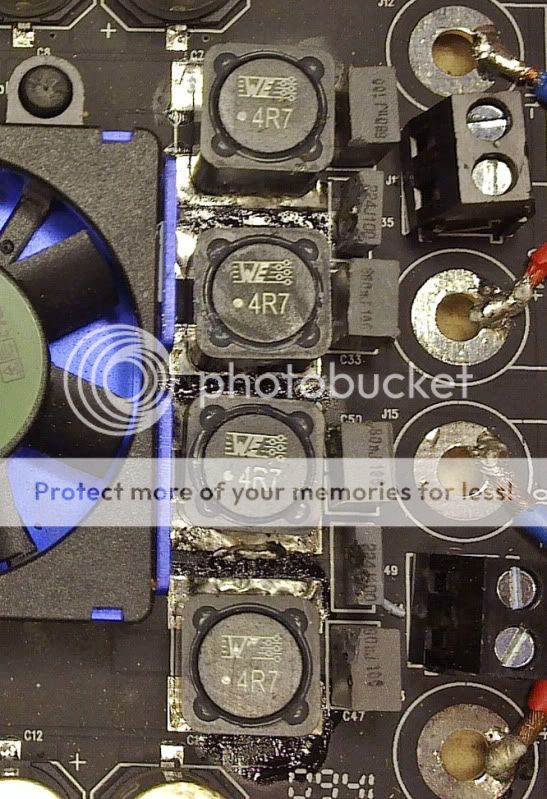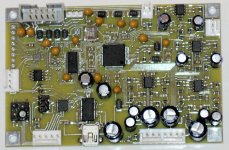Oh no....
Got the Wurths on now with a struggle, horrible experience to be honest. But now getting virtually no sound, ear right up to the cones to hear this.... arrg. The only way I could see of soldering them on was from the top, but the things to the right got a bit scorched.... so why so little sound ? Any ideas please ! I am without sounds now and got friends coming round to watch a movie in a few hours........

They can go either way just the same. I have mine all facing the same way right now. I suppose it is not beyond the realm of possibility that a slight difference in sound could be detected by facing the two outer coils in the opposite direction due to the way that any slight stray leakage may be picked up by the next coil. I probably tried it some where along the line but didn't take note of which way I liked better. Maybe we should roll them like dice and let fate decide.
Got the Wurths on now with a struggle, horrible experience to be honest. But now getting virtually no sound, ear right up to the cones to hear this.... arrg. The only way I could see of soldering them on was from the top, but the things to the right got a bit scorched.... so why so little sound ? Any ideas please ! I am without sounds now and got friends coming round to watch a movie in a few hours........

Release pins
The silver heatsink/ fan comes right off by releasing the pins from underneath. The blue heatsink is glued on and must be heated with some hot air to get the glue to soften up enough to get it off.ive done it.- yay!
now,
how have you guys removed the fan/heatsink? just pulled it off??- not sure im comfy with that one.- i can hear a tiny amount of buzzing through the speakers that gets louder when i physically stop the fan- so i assure the noise is related to the fan?
so far the sound is a little softer- (good for me/my system) and more bass- yum.
Melted caps?
Are the melted caps shorted? Measure across the speaker terminals. It should read 32k ohms. If something is shorted it will read much lower around 1 ohm.
Got the Wurths on now with a struggle, horrible experience to be honest. But now getting virtually no sound, ear right up to the cones to hear this.... arrg. The only way I could see of soldering them on was from the top, but the things to the right got a bit scorched.... so why so little sound ? Any ideas please ! I am without sounds now and got friends coming round to watch a movie in a few hours........

Are the melted caps shorted? Measure across the speaker terminals. It should read 32k ohms. If something is shorted it will read much lower around 1 ohm.
Input termination
Every amp has the input terminated with some resistance one way or the other. It slightly loads the source and cables to keep noise pick up down and get them into their optimum power range of a few milliwatts at least. The gain setting divider also creates a load to a virtual ground in front of the input to the chip but I found that it sounded better for me with the 22k terminating resistors in place.So the board sounded better with 22k to ground on the signal?
Seems kinda strange...
27C with fan
The heatsinks with a fan run about 27C.That heatsink looks good..
whats the temperature with old setup?(fan)
Are the melted caps shorted? Measure across the speaker terminals. It should read 32k ohms. If something is shorted it will read much lower around 1 ohm.
Hi Scott, thanks for telling me this, ok meter set to 200k ohms and get the reading of 32.5, so nothing melted blown then, unless the wurths got too heated in the struggle to get them on ? Have tried wiggling them, but they seem soundly soldered on....
DC offset?
Measure your DC offset while wiggling the coils. If any of them are loose you will see the reading cut in and out. Measure DC between each speaker terminal and ground while wiggling. It should be 1/2 supply voltage.
Hi Scott, thanks for telling me this, ok meter set to 200k ohms and get the reading of 32.5, so nothing melted blown then, unless the wurths got too heated in the struggle to get them on ? Have tried wiggling them, but they seem soundly soldered on....
Measure your DC offset while wiggling the coils. If any of them are loose you will see the reading cut in and out. Measure DC between each speaker terminal and ground while wiggling. It should be 1/2 supply voltage.
I would try replacing the output caps, though it might be another struggle
For future coil replacements: remove output caps, solder coils, place output caps back on.
Way easier
Hmmm, have to come to thinking just that...
Measure your DC offset while wiggling the coils. If any of them are loose you will see the reading cut in and out. Measure DC between each speaker terminal and ground while wiggling. It should be 1/2 supply voltage.
I have taken a good close look with a magnifying glass and my coils are all sitting at angles... Ok, they all need to come off and redoing which will be tricky, and tomorrow I will get a proper soldering iron as I have been using a Weller gun which is way too big to get between the coils. so no sounds today, oh well, at least nothing blown. I guess the best way to get these on is by having both of the soldering plates heated at the same time and have the Wurth just dropped on ?
Now come to think hand wound coils would have been way easier !
Regulated iron
I have a regulated iron which has plenty of power to go quickly back and forth in order to get both sides liquid at the same time.I have taken a good close look with a magnifying glass and my coils are all sitting at angles... Ok, they all need to come off and redoing which will be tricky, and tomorrow I will get a proper soldering iron as I have been using a Weller gun which is way too big to get between the coils. so no sounds today, oh well, at least nothing blown. I guess the best way to get these on is by having both of the soldering plates heated at the same time and have the Wurth just dropped on ?
Now come to think hand wound coils would have been way easier !
My Weller gun is 100w, but as soon as I heated one plate and jumped to the other the first had already set. This did send me rather mad after a bit..... Is your iron more than 100w ? Or perhaps my gun is just too old, bought it in 1979 with wages from my first job and have never used anything else.
If you have a steel feeler gauge, using the finest you have slide it under the size of the coil that you have heated with the soldering iron. The solder will not stick to the steel when it hardens. Then you can heat the other side and just lift off.
If your going to remove the output caps I've found the solder remains in the holes and sets solid and is a pain to reflow. You can use the same trick as above with a steel sewing pin/needle. Put it through the hole when the solder is liquid and pull out when it solidifies.
If your going to remove the output caps I've found the solder remains in the holes and sets solid and is a pain to reflow. You can use the same trick as above with a steel sewing pin/needle. Put it through the hole when the solder is liquid and pull out when it solidifies.
Last edited:
Weller
.
Amazon.com: Weller WTCPT 120 Volt 60 Watt Temperature Controlled Soldering Station: Home Improvement
.
Fries any soldering job right now with an 800F tip. Two irons and three hands would make installing the coils easier. Plenty of liquid flux also helps conduct the heat to the work. I like the feeler gauge idea for removal.
I use the Weller.My Weller gun is 100w, but as soon as I heated one plate and jumped to the other the first had already set. This did send me rather mad after a bit..... Is your iron more than 100w ? Or perhaps my gun is just too old, bought it in 1979 with wages from my first job and have never used anything else.
.
Amazon.com: Weller WTCPT 120 Volt 60 Watt Temperature Controlled Soldering Station: Home Improvement
.
Fries any soldering job right now with an 800F tip. Two irons and three hands would make installing the coils easier. Plenty of liquid flux also helps conduct the heat to the work. I like the feeler gauge idea for removal.
Might work
That might work. Might fry something since the chip is doing the heating. It is tricky either way. I'm glad they went to normal paste on the newest heatsinks. Good thing because the new fan is useless.wouldnt it make sence to disconnect the fan and run the amp to warm, then try and pull the fan off? instead of using a heat gun.
The "disconnecting the fan and warming it up" method is often used with computer heatsinks, to prevent the CPU from being pulled out from the ZIF socket during the removal of the heatsink; I mentioned earlier that thermal paste can get very hard.
Nobody said you have to remove the heatsink while the thing is switched on.
Nobody said you have to remove the heatsink while the thing is switched on.
glue
Yes but this is much more than hard paste. It is rubber glue. luckily they didn't use epoxy or there would be no chance
The "disconnecting the fan and warming it up" method is often used with computer heatsinks, to prevent the CPU from being pulled out from the ZIF socket during the removal of the heatsink; I mentioned earlier that thermal paste can get very hard.
Nobody said you have to remove the heatsink while the thing is switched on.
Yes but this is much more than hard paste. It is rubber glue. luckily they didn't use epoxy or there would be no chance
- Status
- This old topic is closed. If you want to reopen this topic, contact a moderator using the "Report Post" button.
- Home
- Amplifiers
- Class D
- Sure Electronics New Tripath Board tc2000+tp2050
